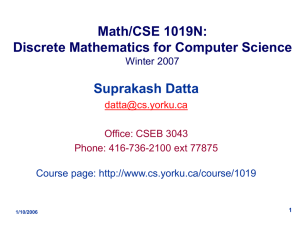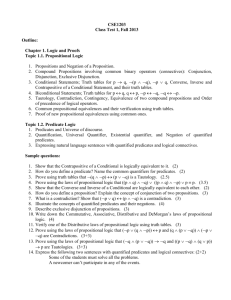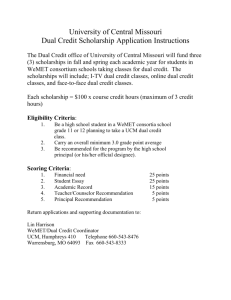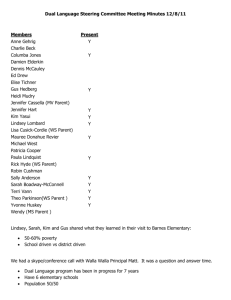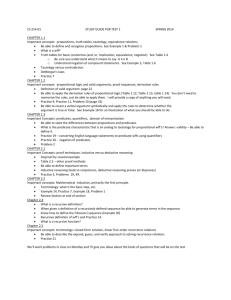Propositions
advertisement
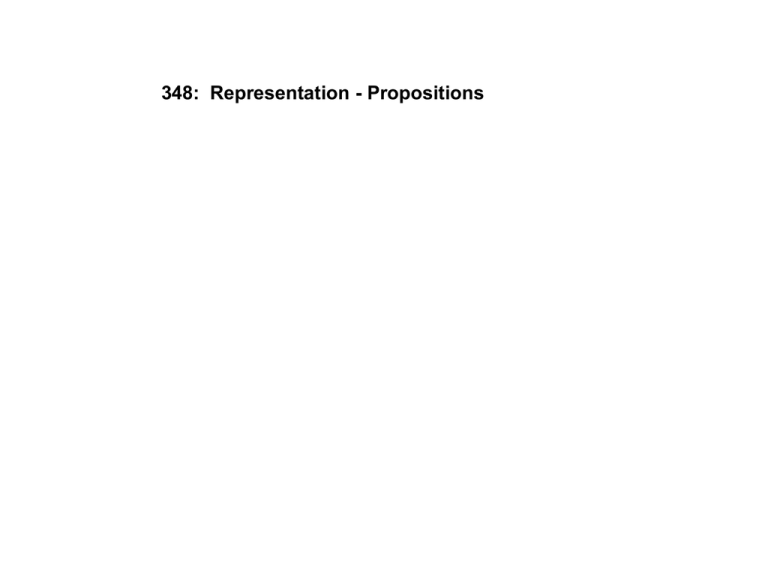
348: Representation - Propositions • • Form a mental image of this picture Which of the pictures on the next slide are part of this picture? 1 3 2 4 Try Again with Another Design • • Form a mental image of this picture Which of the pictures on the next slide are part of this picture? 1 3 2 4 Carmichael, Hogan, & Walters (1932) • Participants were shown simple figures with one of two verbal labels Sun or ship’s wheel Hourglass or table Carmichael, Hogan, & Walters (1932) Results • • • Later participants were asked to draw items seen Participants distorted the images to fit the labels Interpretation: the images may be stored as propositional information Finke, Pinker & Farah (1989) Imagine a capital letter D. Rotate the figure 90 degrees to the left. Now place a capital letter J at the bottom. Draw this shape. Imagine a capital letter N. Connect a diagonal line from the top right corner to the bottom left corner. Now rotate the figure 90 degrees to the right. Draw this shape. Finke et al interpret their results as support for the Dual Code hypothesis: that is, that we are able to construct and manipulate images, and to recognize new objects created by those manipulations. But some theorists (Chambers, Pylyshyn, Slezak) objected to Finke et al’s interpretation. They argued that Finke et al’s “guided” imagery task was not a true test of the Dual Code – Imagery theory, since the task starts with geometric shapes with no particular intrinsic meaning. According to Proposition theory, abstract codes are related to intrinsic semantic meanings that arise from our experiences, our cultures, etc. Thus “images” are semantically rich, not reduced arbitrary shapes. That we can generate images that are analogous to reduced arbitrary shapes is not to say that we in fact encode information that way. A true test would start with “images” of real-world, meaningful objects. If we are able to rotate those and “see” a new, different object, then the Dual Code theory is supported. If we are not able to do that, then Dual Code is not supported. Can Images Be Rotated and Inspected? A Test of the Pictorial Medium Theory. Peter Slezak, 2009 DUCK Make an image of this figure & rotate the image 90 degrees to the right. What is the new image? Make an image of this figure & rotate the image 90 degrees to the right. What is the new image? Most people are unable to recognize the new image from the rotated figure until we actually see a physical image. Interpreted to mean that an abstract/semantic code that we label as “duck” cannot readily be transformed into a different object. This finding supports Propositional theory, which would posit that images arise from abstract codes that include semantically rich information, and thus cannot readily be transformed into a different object with different semantic information. Propositions – Pylyshyn, Anderson & Bower, Chambers Knowledge is represented in abstract forms via language-like structures & processes similar to predicate calculus: Relationship [Subject element, Object element] Examples: “The cat is under the table” = Under [cat, table] “The black cat is under the round table” = Under [cat(black), table(round)] No pictures or actual words are involved The sensation that we have mental pictures or verbal thoughts is simply an “epiphenomenon” of propositional processes Possible advantage is that propositions can represent any kind of relation and any combination of relations, including very complex ones Problem: how do we go from a set of abstracted propositions back to the “concrete” verbal or imaginal code? Answer: mental processes “recreate” the verbal or imaginal code. Problem: How? And what mental processes? Is there a homunculus lurking here? Aside re: homunculus Although Proposition Theory is based on sound rational arguments, it lacks the extensive empirical support that accrues to Dual Code theory. Attempts to contrast the two theories directly have usually supported Dual Code theory. However, some recent evidence suggests that an abstract/propositional code may be involved at least some of the time. Synthesis – Tversky and others re: mental maps We can “create” mental maps from verbal descriptions We can generate images of maps we’ve actually seen Accuracies & distortions are similar for both of the foregoing So perhaps we use both dual code & propositions The foregoing synthesis has the charming & powerful effect of eliminating the debate between dual-code & propositional theorists. However, this synthesis may be too powerful. That is, by explaining everything, it explains nothing, since it cannot be readily tested. Karl Popper must be “rolling in his grave” when he considers this tendency in psychology to drift toward universal theories that are not susceptible to his Falsifiability doctrine for good scientific theory! General summary: So three possible codes: verbal, pictorial, propositional Dual code / functional equivalence theories have overwhelming empirical research support. Propositional theories tend to rely on rational arguments & less empirical research. Currently the two positions are usually portrayed as mutually exclusive: one is right and the other is wrong. Most cognitive psychologists currently go with dual code / functional equivalence. Barbara Tversky & others: maybe the two positions are not exclusive, but rather we use propositions in some circumstances & dual code in others. Visual imagery is often used in memory tasks, problem-solving, skills training, and meditation. FIN

